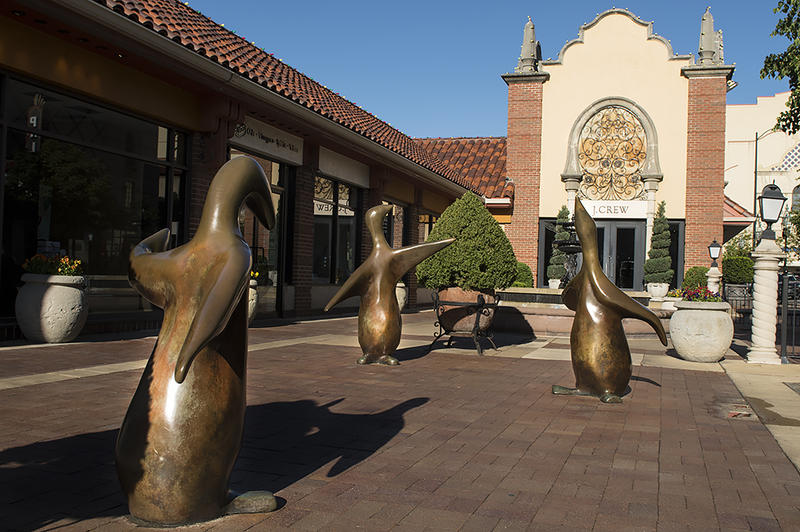His Work Is In Peril, So Here’s What You Should Know About Kansas City Artist Arthur Kraft
By LAURA SPENCER • MAY 2, 2017
‘Court of the Penguins’ on the Country Club Plaza, probably one of Arthur Kraft’s best-known works in Kansas City. The five-foot tall bronze sculptures were cast after Kraft’s death and installed in 1979.
JULIE DENESHA / KCUR 89.3
A painter, sculptor, and muralist, Arthur Kraft was an artist who, as he put it, wanted to be “left alone to create.” Kraft died in 1977 at the age of 55 after struggles with alcoholism and cancer.
Forty years after Kraft’s death, his work is sought-after by collectors. And some of it is still on public view in Kansas City, such as a mosaic at 12th and McGee, a sculptural waddle of penguins on the Country Club Plaza, and a mural inside a bank at Westport Road and Broadway.
The future of this Westport building is uncertain — there’s talk of tearing it down and replacing it with a six-story apartment complex.
But, according to the Westport Historical Society, they have ownership of Kraft’s mural with “plans to have it taken down, restored, and placed in a new home.” A location has not yet been confirmed, but it’s likely to be moved in August.
With the Kansas City Plan Commission expected to take up the Westport bank site’s future again on May 16, here are five things to know about artist Arthur Kraft:
1. He started early.
Kraft grew up in Kansas City, Missouri, and took to painting at age 5, when he borrowed a friend’s watercolor set. By 13, he was selling decorated matchboxes and oil portraits at the Plaza Art Fair.
Classes on Saturdays at The Nelson-Atkins Museum of Art marked his first formal art training. Kraft graduated from Southwest High School, and studied for a semester at the Kansas City Art Institute. After serving in the Army during World War II, he earned a degree from the School of Fine Arts at Yale University in 1946.
2. He said Kansas City was his place to create.
Kraft earned an Alice Kimball English Award in 1946 to study abroad while he was at Yale. His first one-man exhibition was in Paris. He also exhibited work in London, Rome, and New York, as well as in other cities. His illustrations were on the covers of magazines such as Fortune.
And, the U.S. Junior Chamber of Commerce named him one of “America’s Ten Outstanding Young Men of 1954.” Some of his contemporaries included Robert Kennedy and Chuck Yeager.
But he returned to Kansas City in the late 1940s and continued to call it home.
“He felt that here he didn’t have to give people what they wanted,” Reed Anderson, the curator of a retrospective exhibit, told The Star in 2002. “He could give them what he wanted, what was important to him. Money wasn’t important to him. All he wanted to do was create.”
3. He wasn’t good with money.
“Zero gives me trouble,” Kraft told The Star in 1970. “Have you ever thought about zero? I’ve spent a lot of time contemplating it.”
The article, headlined “Accounts Acrid to an Artist,” reported that Kraft was estimated to be more than a year behind in rent for his apartment at 3643-45 Warwick Boulevard.
According to his friends, Kraft gave a lot of his work away.
“I don’t have a sense of money,” he told The Star.
In a remembrance of Kraft, Allen Schreiber recalled that “he placed his earnings into a Swiss bank account but he could not remember the bank or account number.”
4. He created artwork for shopping centers.
Kraft designed whimsical animal sculptures for malls across the Midwest — “a 10-ton laughing elephant at a Detroit shopping center, penguins at a center in Indianapolis center and a trio of walruses for a Cleveland center,” as described by The Kansas City Times in 1977.
His brass rod sculpture “The Peacock,” from a now-closed mall in Southfield, Michigan, was on view in April for the Michigan Modernism Show. Officials told WXYZ in Detroit that it was re-discovered just a few months ago as they were cleaning out the mall.
“The piece fell into disrepair and was stored in the basement of Northland,” said Southfield Mayor Ken Siver. “We thought it was lost.”
Fundraising is underway to repair the sculpture for public display.
5. He spent time in mental hospitals.
In the summer of 1971, Kraft was admitted to the alcoholic ward of St. Joseph’s State Mental Hospital No. 2. He stayed for five weeks. It was his second time in a mental hospital.
Kraft released a limited-edition book, The Sounds of Fury, later that same year, with color reproductions, black-and-white sketches and stories about some of the patients.
Of one patient named Nettie, he wrote, “She was a lost soul — but she managed to give the appearance of a little style with a red blanket that she clutched as if her life depended on it.”
And of Fred, who had been a circus performer: “He had projected himself onto that trapeze. He wanted to be over and above all the people — the star.”
In 1972, Kraft told The Kansas City Times that the experience gave him a sense of urgency about his work.
“I don’t want to waste any time,” he said.
This article was written with research support from the Spencer Art Reference Library’s Artists’ File Initiative at The Nelson-Atkins Museum of Art. For more images of Arthur Kraft’s work, check The Wonderful World of Arthur Kraft website.
Laura Spencer is an arts reporter at KCUR 89.3. You can reach her on Twitter at @lauraspencer.
